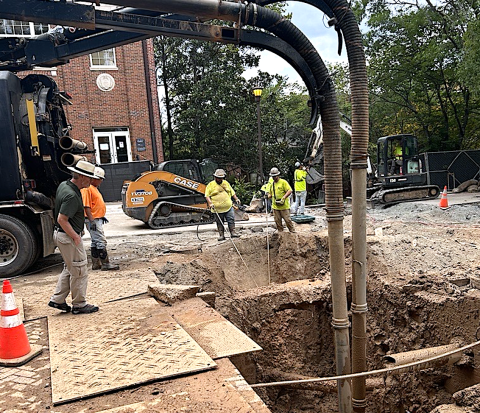While remnants of the recent chilled water outage remain in Harrison Square, operations are mostly back to normal following an around-the-clock operation executed by multiple departments across the Institute.
When pressure readings at the Holland Plant dropped drastically in the early morning hours of Friday, July 26, Jim Stephens, vice president of Infrastructure and Sustainability (I&S), knew what that meant.
Despite a year of bypasses and other mitigation strategies around a chilled water system leak underneath Cherry Street in Harrison Square, the leak grew and led to a widespread outage across campus. Classrooms, research labs, offices, and other vital spaces were without air conditioning.
The I&S team had run through this exact scenario during its continuity of operations planning with the Office of Emergency Management. So, as the sun rose that Friday morning, a plan was in place. Crews began excavating to isolate the leak 20 feet underground, and the team started securing mobile chillers to protect vulnerable research labs and buildings against equipment failure, mold, and other potentially detrimental side effects of rising temperatures and humidity.
Meanwhile, students on campus for the summer session were preparing to take finals in classrooms that were suddenly without air conditioning.
Assessing the Situation
Stephens likened the situation to triaging in an emergency room. He followed the example set by his mother, a pediatric cancer nurse.
"You have to be keenly focused on the next steps you need to take. You want to solve all the problems, but you may not be able to. What you can control is that next step and make sure you've got as many things covered as possible. That way, you're going to make the best of the situation you have,” he said.
Stephens and Emergency Management met with Institute leadership daily (and often twice daily) to ensure that resources were properly deployed to minimize the impact on operations.
The Work Begins
Led by Executive Director of Infrastructure Greg Spiro and Associate Director of Utilities Will Varnado, excavation crews continued around-the-clock operations to isolate the leak under Cherry Street and replace a pipe that had been there since the 1960s — working carefully to avoid surrounding electric and gas lines. Meanwhile, a secondary leak by the Dalney Building threatened to make matters worse by taking the Biotech Quad offline. Repairs were quickly made to alleviate the pressure and bring chilled water back to the research hub.
I&S estimated that the repairs would take two to four weeks; in the meantime, mobile chillers arrived on tractor-trailers to serve as a temporary solution. Associate Director of Infrastructure Services Jamie Ready and her team quickly secured chillers from across the country, and within the week, units arrived to be placed around campus. Laboratory and Chemical Safety Officer Alicia Wood-Jones and Environmental Programs Manager April Kelly were charged with identifying hazards in more than 2,000 lab spaces during the outage, as well as promoting compliance in any needed repairs. At the same time, Emergency Management and the Office of the Provost enacted contingency plans for final exam locations.
Among the most affected buildings on campus was the Price Gilbert Memorial Library. Home to 30,000 books and collections, the Library quickly reached indoor temperatures in the high 90s with 85% humidity. Archives and rare books were at risk. Library staff moved artwork into a central cool zone operating on a chiller and a dehumidifier and moved all physical collections to the Clough Undergraduate Learning Commons. Collections are currently being cleaned by hand and returned to the Library, but it will take several months to return them all to the shelves. Nearly all books are available online and by delivery from the Library Service Center.
As the outage stretched into August, I&S worked to bring student-facing facilities like Stamps Health Services and the John Lewis Student Center back online before move-in.
"This effort seems like one long day because it never really stopped," Stephens recalled.
Moving Forward
As workers installed new bypasses and pipes, they added pressure back slowly to avoid overloading the system. When students returned to campus the weekend of Aug. 10, air conditioning had returned to most campus buildings.
The Harrison Square excavation, which will continue during this academic year, presents an opportunity to rework aging sections of the chilled water system and "do it in a way so we won't have to fool with it for the next 50 years," Stephens said. He and Spiro emphasized the importance of creating a more redundant system, allowing chilled water to reach all areas of campus via multiple pathways. Another driving force in the repairs has been the continued electrification of campus heating and cooling operations to further align with the Climate Action Plan and the Institute's goal of reaching net-zero emissions by 2050.
Having worked in Florida, Stephens has a background in hurricane preparedness, and the urgency to plan for the worst-case scenario guides his approach in his work. He never wants to experience another chilled water outage, but if one arises, he knows he's surrounded by the right team.
"The true success of this story was the planning and the people at this institution working together for a common goal," he said. "If there's any message that outlives this crisis, it's that when we all decide to focus on accomplishing a common goal, we can do incredible things together."
